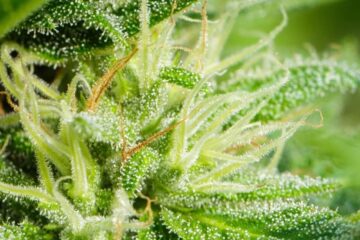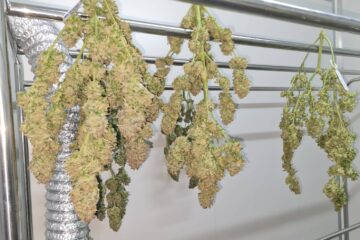Don’t Let Botrytis (Bud Rot) Ruin Your Cannabis Crop
As an outdoor grower, in the dank Jungles of Thailand, I’ve battled grey mold and bud rot before.
I have witnessed hundreds of kilos of cannabis rotting in the field.
When climate conditions favor infection, these fungal diseases can rampage through a flowering crop like the zombie apocalypse. Few things are worse than watching something you have nurtured be consumed by disease.
What is Botrytis?
Botrytis is a genus of pathogens responsible for plant diseases that cause billions of dollars per year in crop loss. These necrotrophic fungi kill their plant hosts to feed on rotting tissue. Botrytis Cinerea is the most phenotypically diverse of the 40 or so Botrytis species that have been identified. This pathogen infects thousands of plant species worldwide and has evolved resistance to many fungicides.
B Cinerea is present everywhere from Amazon rainforest to Arctic tundra.
It lurks on the keyboard that I write this upon and drifts in the air that you breathe as you read it.
Conidia Germination:
Botrytis reproduces primarily through airborne spread of conidia. These asexual spores require specific environmental conditions to germinate and infect your plants. This disease is reliant on high humidity or liquid water to colonize plant tissue, and spreads most quickly at moderate temperatures (60-80 F). Following germination, Conidia will produce germ tubes within a few hours, followed by increasingly complex hyphal structures to colonize dying plant tissues. Similar to Mycorrhiza. Due to its endemic nature, exclusion of this pathogen from your facility through biosecurity measures is unrealistic.
Botrytis Sporulation:
Sporulation is the phase of disease development where conidiophores form on colonized plant surfaces.
A conidium, sometimes termed an asexual chlamydospore or chlamydoconidium, is an asexual, non-motile spore of a fungus. The word conidium comes from the Ancient Greek word for dust, κόνις. They are also called Mito spores due to the way they are generated through the cellular process of mitosis.
These reproductive structures form conidia to enable airborne spread to nearby plants. Thus just like Powdery Mildew and other Fungi precautions should be in place.
Sporulation is favored by cool humid conditions and senescent (dying) plant material. (Cleanliness). Seasonal cues drive production of sclerotia. These hardened conidia are capable of overwintering in soil and crop residue to germinate when conditions are favorable. (Can be transmitted by a Visitors Tennis Shoes or “Treaded Patterned” Shoe base. Make Visitors wear “Shoe Condoms.)
In spring conditions outdoors, these conidia can contact plant hosts through rain splash or airborne spread to begin the seasonal disease cycle as well. Highly Transferable.
Plant Defenses:
Plants have interacted with microbial pathogens for hundreds of millions of years and have evolved complex defensive systems. Plant cell walls provide a primary protective layer against a variety of invaders. This feature is enabled by plant health and nutrient availability. Having a Proper Living Soil is vital. Silica and Calcium contribute to rigid cellular structures, and micronutrients like Boron assist the destruction of pathogen cell membranes.
These attributes can prevent penetration of living cells by Botrytis hyphal structures. Plants which are fed excessive Nitrogen may be more susceptible to Botrytis infection.
Disease Development:
To overcome these barriers, Botrytis employs multiple invasion strategies. Senescent or decaying tissues are the first to be infected as plant defenses are no longer functional. This is a natural process of Nature.
Following germination, Botrytis hyphae secrete oxalic acid to lower the PH of adjacent plant tissue. This increases the efficacy of Cell Wall Decaying Enzymes and various toxic metabolites that are excreted to target cellulose, pectin, and other cell wall materials. As cells are breached, infection can spread rapidly to adjacent tissues.
Immune response:
Your plants will quickly recognize the chemical signature of Botrytis infection and respond to this existential threat. Plant immune response is enabled by hormone signaling systems and includes production of antimicrobial compounds, and enrollment of soil microbes to support plant defense. At a molecular level, plant resistance genes will be up regulated by hormone signaling to accommodate the threat environment.
Botrytis has evolved countermeasures to these plant defenses which include silencing of hormone signaling through chemical synthesis, and deployment of small RNA to disrupt plant defense at the genetic level.
These chemical warfare tactics have evolved to a level of complexity that defies complete characterization. The extent to which we can understand these interactions enables us to bolster plant defenses using a few blunt tools.
Stress Priming:
We can stimulate a plants natural immunity by proactively signaling to our crops that they are under pathogen attack. Regalia is a branded pesticide that has demonstrated efficacy in stimulating a robust immune response in cannabis plants. This extract of the giant knotweed plant stimulates ISR and SAR plant immune systems through interaction with phytohormones including Jasmonic, and Salycilic acids.
These hormones signal that the plant is under attack and elicit a protective immune response involving production of antimicrobial and volatile organic compounds.
Cannabis Bioprotectants:
Bioprotectants are living agents, or their metabolites, and have proven efficacy to treat many cannabis diseases. These bioprotectants are functional due to multiple modes of action.
Competition – Beneficial microorganisms can outcompete pathogens for food sources and physical habitat when environmental conditions promote their proliferation.
Chemical Warfare – In addition to metabolites that inhibit pathogen growth, microorganisms produce more than 1300 volatile organic compounds (VOCs) of diverse chemical classifications.
Immune Response – Microorganisms can solicit plant immune responses through hormone signaling pathways.
Fungus Contact killers:
In addition to use of bioprotectants, several other chemicals are commonly used as contact killers in cannabis ecosystems. These pest control products can destroy conidia on contact and have an important role in prevention of pathogen establishment.
Horticultural oils: Efficient suffocates for sporulation of conidia. Counter indicated for use in conjunction with Sulfur. Potassium Bicarbonate: Raises the PH of treated plant surfaces to preclude infection by acid loving pathogens like Botrytis. Sulfur: This fungicide has multiple modes of action making evolution of pest resistance more difficult. Hydrogen Peroxide: Oxidization is a powerful antibiotic tool and several branded pesticides have formulations to employ this function.
Spray Operations:
Spray applications are an important preventative tool and can be applied until about two weeks after flower induction. Never Spray any type of Liquids upon Flower. Dense cannabis flowers should never be sprayed. In addition to the problem of microbial contamination and residues on a consumable product, spray applications will increase the flower’s interior humidity and create conditions for spore germination.
Pest control products with different modes of action are best used in rotation.
Caterpillars can be a contributing factor to Bud Rot. These herbivores cause plant injury while feeding, and their manure provides a nutrient source for disease establishment. Caterpillars can be preventatively managed through use of Pesticides containing BTK, a bacterium that is safe for most organisms, but deadly to caterpillars.
Climate Management:
Bud Rot disease can be eliminated in facilities where the climate can be precisely controlled. Moderate temperatures, high humidity and free water on plant surfaces favor disease development. If humidity can be managed to below 60% and cultivators resist spraying their flowers (please?) you should have no issue with this disease. Outdoor and greenhouse growers must take preventative action to minimize the possibility of crop loss during seasonal conditions. Check all of your Plants regularly.
Outdoor growers can influence the climate by timing outdoor harvests for the optimal seasonal window, and by pruning to improve airflow.
Dewpoint and Bud Rot:
The dewpoint is the temperature at which water will condense at the ambient humidity. These conditions are typical in predawn conditions as temperatures cool in the fall. Liquid water promotes germination of Botrytis conidia. Water is the solvent of Life. Growers can determine through a psychometric chart if the dew point will be crossed at various humidity and temperatures.
For greenhouse operators, it can be helpful to open blackout curtains during the night cycle and run higher nighttime temperatures to manage peak humidity levels. Or use Commercial Fans. Outdoors it is important to locate cannabis crops where they will receive direct sunlight early in the morning to dry the dew. I use Commercial Fans Outdoors also.
Mold Resistant Strains:
There is a notable difference in susceptibility to bud rot among various cultivars. Many of the heritable characteristics that help to limit susceptibility to this disease are related to plant morphology. Densely clustered colas foster disease development, while smaller flowers, and longer internodes allow for better airflow and disruption of humid microclimates. This aspect of disease resistance involves many different genes which are separately inherited.
Multiple generations of breeding are required to fix these horizontally inherited traits. As cannabis is typically vegetatively propagated, it is not always necessary to breed for resistance when naturally resistant cultivars can be selected from large populations.
Botrytis in Propagation:
Propagation climates can provide perfect conditions for disease establishment. Botrytis will cooperate with other fungal and oomycete pathogens including Fusarium and Pythium species to infect seedlings and cuttings. These cannot be seen with the Naked Eye. When performing Tissue Cultures, Fungi will be your top Concern.
This colonization contributes to damping off disease, wilting, and leaf lesions. Several bioprotectants, including B subtilis, S lydicus, and T harzianum have shown efficacy in disease suppression when used as a drench for propagation media.
Grey Mold Infection:
High humidity and cool temperatures can cause fungal infections of plant stems early in the developmental cycle. This disease is commonly referred to as grey mold, or early blight. This disease is much less prevalent in cannabis than diseases that occur later in the crop cycle. Early blight commonly occurs first on plant stems within the humid understory of the crop.
As the fungus enters its reproductive stage, fuzzy mycelial growth will form visible lesions on infected stems. These lesions can quickly encircle the stem, damaging vascular tissues, and killing plant parts above the infection site.
There is evidence that Botrytis can live as an endophyte within many plant species, with no outward sign of infection until conditions favor sporulation. By the time this disease can be identified by sporulation, significant damage to vascular structures has likely occurred, so preventative measures are required to manage this threat.
Prevent Botrytis Establishment:
Pruning is required to enable airflow through the canopy to promote plant health. Or a “Forced Airflow’ will help “dry” things out a bit. Also assist in in Plant Transpiration. Remember that pruning a Plant cuts the plant and creates wound sites that can provide an ingress point for disease establishment.
Pruning of lower branches should occur before peak humidity conditions caused by biomass growth and weather events. Early pruning activities should be immediately followed by a spray application of a contact killer to destroy conidia prior to opportunistic infection.
Micronized Sulfur is a pest control product that is widely accepted as safe and can provide a lasting benefit when applied to the canopy understory. This pest control product is difficult to keep suspended in solution and should be applied using tank agitation or low volume foggers.
Bud Rot Management:
Bud rot is a condition that usually effects cannabis crops late in their development cycle when a combination of dense flowers, high humidity, and senescent plant material provide perfect conditions for disease. This disease forms within pistillate masses at the juncture of leaf petioles where direct contact with spray or light treatments is not possible.
Infection causes leaves protruding from the flowering mass to twist and turn yellow, enabling visual disease detection. Infected tissue should be removed carefully to avoid contamination of nearby flowers, and release of spores.
A focus on influencing the biology inhabiting flowers during formation can have enduring benefits on mold resistance. Typical preventative measures include uvc light treatment to prepare new flowering sights for beneficial inoculation with an approved bioprotectant.
Mold in Post-Harvest:
The threat of mold does not end when plants are harvested.
Grey mold can continue to spread during the drying and curing processes, and buds should be carefully inspected at harvest with infected product bagged and tagged. Leaves protruding from bud sites that are yellowing merit further visual inspection by opening the floral mass to detect necrotic tissue. Some experienced plant workers can detect the presence of rot within dense floral masses by the distinctive sour smell that develops.
Curing chambers should be designed to enable airflow, room air should be cleaned with two step filtration (particulate-uvc) and regular visual inspection by experienced personnel should be performed. (Ultraviolet light in the C spectrum (UV-C) is energy-rich light with a wavelength of 200 – 280 nanometres (nm).
Prepare for the Apocalypse:
If you are unable to precisely control your grow environment, you will need to use every tool in the box to minimize destruction by these necrotrophic zombie hordes.
Know your enemy.
Scout your crop.
Support your plants natural defenses.
If you wait until you see Botrytis sporulation, it might already be too late.
Kevin


